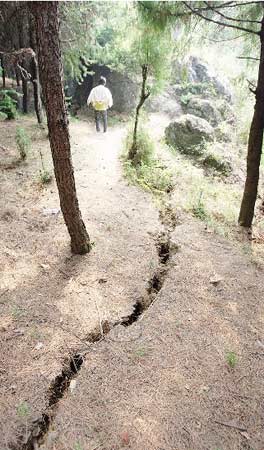On May 12, the devastating earthquake hit Qingchuan, a small area in the north of the Sichuan basin. Before the quake, Qingchuan was renowned for its beautiful scenery and abundant flora and fauna. After the quake, what should the county do to manage reconstruction and restore development?
Qingchuan's green mountains and limpid waters had always been a source of pride and hope to its people.
However this ancient north Sichuan town was severely stricken by the May 12 earthquake: 98 percent of the houses were damaged, more than 4,000 people died, tens of thousands of mountain dwellers are still trapped deep in the mountains, and a huge Quake Lake was formed above Qingzhu River by two fallen hills.

A big crack cuts across a mountain in the back of Qingchuan County
Since the tragedy, Qingchuaners need to draw a lesson from this bitter experience. In the face of the earthquake, Qingchuan has altered its guiding principle from “man is bound to conquer nature" to "forests will increase as men retreat", a principle that will be better respected after this natural disaster.
Qingchuan's natural scenery
Before May 12, Xiang Mingyue and Dong Jun had always thought Qingchuan as the darling of Mother Nature.
"As you can see in the map, Qingchuan sits right on the borderline of the three provinces of Sichuan, Shaanxi and Gansu – it's a place of blessing," Xiang Mingyue, former vice chairman of the Qingchuan County Committee of the Chinese People's Political Consultative Conference, told Beijing Times in the office of Qingchuan earthquake relief headquarters on May 25.
Xiang came to Qingchuan in 1965 from nearby Santai County as a member of the agricultural production brigades. Back then, Qingchuan was rich in clear brook-waters and graceful and delicate mountains. According to historical records, this is where the name of Qingchuan came from.
"There were many so-called 'Fish Holes' along the Qingzhu River. Every year when the peach blossom bloomed, hundreds of fish would swarm down from the crevices at night, barely a space between the tail of one and the head of the next," Xiang recalled. "Bigger fish could weigh about one jin (Chinese weight equivalent of 500 g), even smaller ones weigh as much as half a jin."